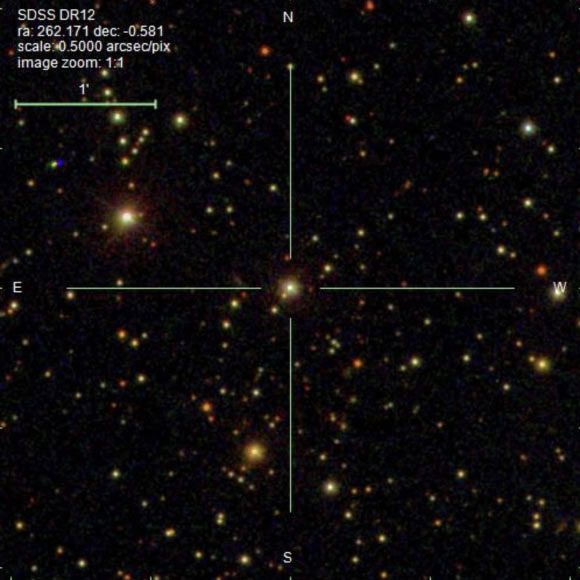The “monster” behavior has revealed a stellar-mass black hole through a telescope, closer to us than any other known black hole.
According to Science Alert, this is a stellar-mass black hole from the binary star system Gaia DR3 4373465352415301632, accompanied by a star slightly smaller than the Sun. They are located about 1,550 light-years away from Earth, making this the closest black hole humanity has ever detected.
“Calculations suggest that stellar-mass black holes must be very abundant, with about 100 million of them in the Milky Way,” stated Professor Sukanya Chakrabarti from the University of Alabama, a member of the research team, as reported by Sci-News.

The bright point at the center of the image is the pair Gaia DR3 4373465352415301632, where the visible star is hiding a giant companion trying to pull it in – (Image: Sloan Digital Sky Survey / Chakrabarti)
However, he added that such black holes are very difficult to observe. The black hole itself is elusive because it has swallowed all the light that could help us see it. However, if fortunate, humanity occasionally discovers a black hole through the light from the jets it emits while consuming matter or through its influence on other objects.
In the case of this nearest dark monster, it is trying to pull in its companion, a behavior commonly observed in a black hole-star pair.
In this study, Professor Chakrabarti’s team analyzed data from nearly 200,000 stars collected by the Gaia satellite from the European Space Agency (ESA).
They classified objects showing signs of having a large companion, with a mass equivalent to a star, tugging on the object itself, but the companion could not be seen.
These objects were then re-examined using a series of other ground-based telescopes, leading to the discovery of the pair.
The black hole in the Gaia DR3 4373465352415301632 pair has a mass of about 11.9 times that of the Sun, having once been a massive star before exhausting its energy and collapsing through several stages, ultimately becoming a black hole. Its companion has a mass of only 0.91 times that of the Sun and is 7.1 years old.
With an orbit of up to 185 days, the two objects are quite far apart, so even though the small star is continuously being “shaken” and pulled by the black hole, there is a chance it may escape in the long run.


















































